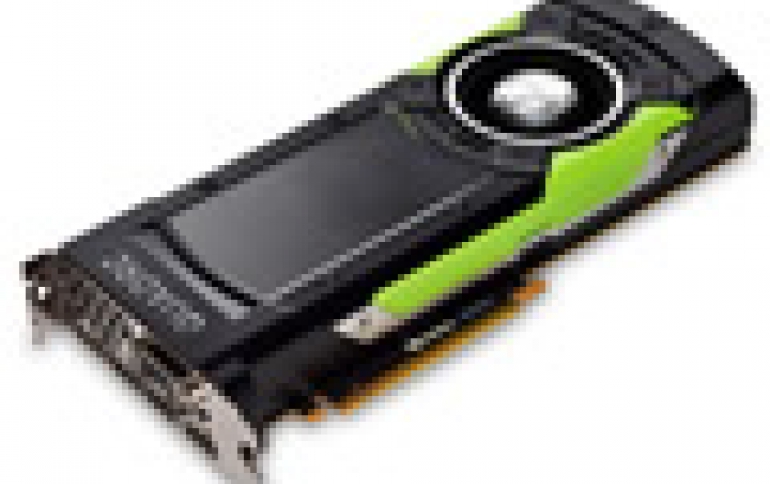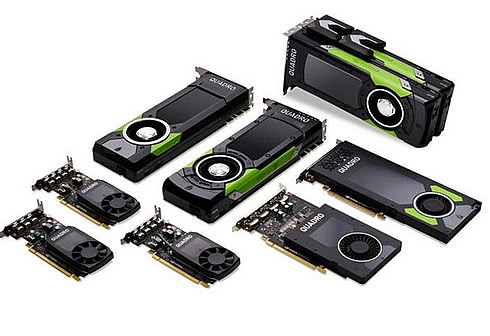
NVIDIA Powers Supercomputing Workstations with New Quadro GP100, Announce Quadro Pascal Refresh
SOLIDWORKS kicked off on Sunday and NVIDIA announced a literal Big Pascal product launch for workstations, including the GP100, along with six new Quadro Pascal cards.
At a high level Pascal and the cards based on it bring with them a few core improvements over previous generation Maxwell and Kepler cards. This includes much greater performance thanks to the smaller 16nm manufacturing process and resulting wider GPUs, single-port support for 5K@60Hz monitors thanks to DisplayPort 1.4, and Simultaneous Multi-Projection (SMP) for VR.
The new NVIDIA Quadro Pascal-based lineup provides an enterprise-grade visual computing platform that streamlines design and simulation workflows with up to twice the performance of the previous generation, and ultra-fast memory.
The new generation of Quadro Pascal-based GPUs are the GP100, P4000, P2000, P1000, P600 and P400.

The GP100 combines double precision performance with 16GB of high-bandwidth memory (HBM2). With 720GB/sec of memory bandwidth - thanks to 4 HBM2 stacks clocked at 1.4Gbps each - the Quadro GP100 has 66% more memory bandwidth than the Quadro P6000's 432GB/sec.

The card also offers ECC memory, half-speed FP64, and double-speed (packed) FP16 instructions. It also introduces a new NVLink connector for PCIe cards. This allows for a pair of Quadro cards to be linked up in a 2-way NVLink configuration, bringing with it NVLInk's memory access and low latency data transfer benefits to PCIe cards.
Nvidia says that the GP100 provides more than 20 TFLOPS of 16-bit floating point precision computing.
The Quadro GP100 packs the typical Quadro family hardware features. This includes 4 DisplayPort 1.4 ports and a single DVI port for display outputs, and NVIDIA is classifying it as VR Ready as well. Meanwhile towards the rear of the card are the Quadro Sync and Stereo connectors for synchronized refresh and quad-buffered stereo respectively.
Nvidia is expecting the Quadro GP100 to ship in March.
Nvidia is also announcing a refresh to the rest of the Quadro family. At the mid-range of the market are the Quadro P4000 and P2000. As the more powerful of the two, the Quadro P4000 is based on a cut-down GP104 GPU, the same GPU used in the Quadro P5000. However unlike the P5000, the P4000 has been cut down to size as a single-slot card. With respect to performance on paper it should deliver right around 2x the performance of the M4000, and it can do so with a TDP of 105W, 15W lower than its predecessor. It is also the lower-tier card that NVIDIA still classifies as VR ready.

Replacing the Quadro M2000 is the Quadro P2000. This card is in the same single-slot form factor as the P4000, but it drops down in power and performance, being built off of a GP106 GPU. Performance should be around 66% percent faster than its predecessor with the same 75W TDP. Nvidia didn't opt to go with a fully-enabled 192-bit memory bus on this card; instead only 5 channels (160-bits) are enabled, which is also why it offers the more unusual memory capacity of 5GB.

Both cards come with 4 full-size DisplayPort 1.4 connectors.
The new low-profile Quadro P1000 is replacing the GM107-based K1200, the P1000 is the most powerful of the low-profile Quadros. It uses a cut-down GP107 GPU clocked at around 1.4GHz. The card's TDP has drifted up just slightly from 45W to 47W. Meanwhile due to its size, NVIDIA has shifted to mini-DisplayPort connectors here.

The Quadro P600 is essentially a lower-performance version of the P1000. It drops down to 1.1 TFLOPS and retains the 4 mini-DisplayPort connectors. TDP on this part is 40W, down from 45W for the Quadro K620. In addition, this low-end Quadro is getting an upgrade to GDDR5.

The Quadro P400 shoudld offer double the performance of the K420. It is rated at 30W, versus 41W for the K420. Note that relative to the P600, the P400 loses a mini-DisplayPort.

These new Quadro cards will start to arrive in March.





















